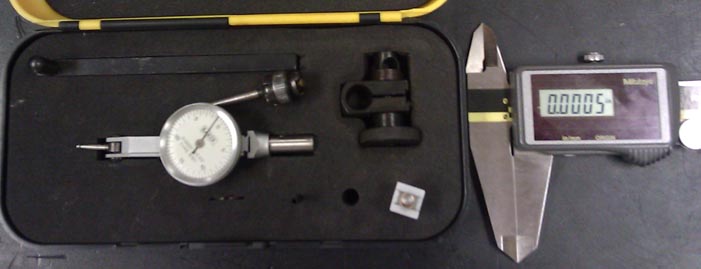|
Measuring and compensating for backlash on a Techno CNC Router
Backlash occurs when there is space between drive components in a system. If
the components do not completely and thoroughly mesh, when the system changes
direction, the space between the parts needs to be taken up before the system
will move. The result of large amounts of backlash can be flats on round parts,
cuts that aren't as long as they should be and poor cut quality.
When the CNC router moves too short of a distance, the problem may be
backlash. The symptoms of backlash are as follows:
- No matter what distance is moved (1” or 10”), the loss in travel is the
same
- The loss of travel is between .001” and .04”
- The loss only occurs sometimes
To test for backlash, you will need a dial indicator or a set of calipers.

Backlash is tested one axis at a time.
If you are using a dial indicator:
- Lock
out power to the spindle only, leave the machine running.
- Place the dial indicator in a collet and inside the spindle. Put some
tape on the spindle to keep it from spinning.
- Face the dial indicator in line with the axis you wish to test.
- Bump the dial indicator into a part located solidly on the machine. Make
sure the needle has moved.
- Zero the machine and the indicator while the indicator is against the
part.
- Set the CNC interface to “Step mode” and a step distance of .001”.
- Reverse direction and move away from the part.
- When the needle on the indicator moves for the first time, read the value
of the axis in the upper right corner of the CNC interface. This value, minus
the value on the dial indicator, is the amount of backlash in the system.
- Repeat the test to ensure the number is accurate.
If you are using a set of calipers:
- Jog the axis in one direction
- Open the calipers to 2” and zero them there.
- Set the machine to jog step, and set the value to 1”
- Lower the speed for the axis to approx 50IPM
- Place the calipers against a part of the axis that moves, holding them
tightly against a non moving part (see image). The calipers must be
perpendicular to the axis. If they are at an angle, the measurement will not
be accurate. Most calipers have a flat edge which can be used to ensure
perpendicularity. Put them on the side that will be traveled towards when the
machine reverses direction from the direction in #1
- Jog the axis towards the calipers
- The calipers should read 1”. If they read less than 1”, the value less is
the backlash.
- Repeat the test to confirm.
Backlash can come from a few different places. After finding backlash in an
axis, check that the mechanics are tight by inspecting:
- Pulleys: Make sure set screws are tight and at least one set screw is
touching a flat on the shaft to which it is attached.
- Belts: Belts should not have much slack in them. Proper Belt
Tightness is important.
- Check the Ball
Screw End Bearings that hold the screw in place
- Check the Ball
Nut Preload
It is preferable to compensate for backlash by solving the problem with the
mechanics if possible, especially if the backlash is greater than .005". When
adjusting mechanics, follow the instructions. Over-tightening mechanics can
result in even worse performance than under-tightening.
Using software backlash compensation on a techno cnc router
Once you have the amount of backlash in the machine calculated (.002 to
.005”), multiply it by the scale factor (Setup->System) for that axis to
obtain the number of pulses to compensate by. .005” backlash on an axis with a
scale factor of 12192 is 61 pulses of backlash (rounded up from 60.96)
Enter this value into backlash comp in Setup->options for the axis you are
compensating for.
Note that this value will not have an effect while jogging the machine. It is
only applied while running a file.
Cut a test file and measure to confirm success. If you hear a “thunk” from
the machine when the axis changes direction, backlash compensation is likely too
high. |

